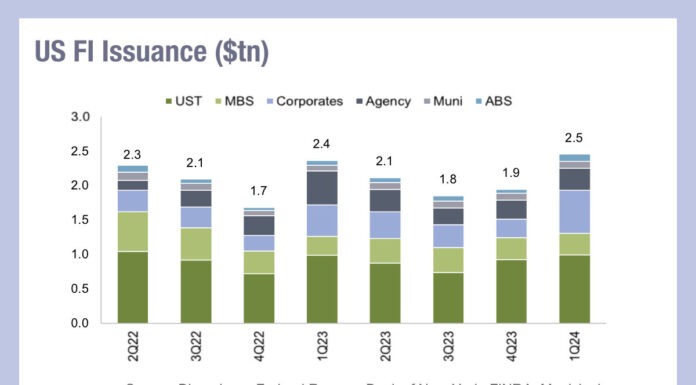US markets have had an eventful summer according to analysis by Coalition Greenwich, which saw an average daily notional volume (ADNV) for US Treasuries up 19% compared to August of 2022, reaching at US$744 billion.
“The strong volume came with volatility that was 5% lower than last year—a sign that perhaps the market is transitioning from ‘bad’ volatility to ‘good’, even though volatility is still well above long-term averages,” wrote author Kevin McPartland, Coalition Greenwich. “Nevertheless, 2023 is in the running to the be the first year in history that the monthly US Treasury ADNV traded never dips below $600 billion.”
At the same time, US Treasury futures ADNV grew at 35% year-on-year, producing a futures-to-cash ratio of roughly 120%, the highest level for that metric since February 2020.
“CME is the clear winner here and is looking to further capitalise on the trading demand for Treasury futures with the pending October launch of new Treasury Bill futures. Seeing that announcement, our first thought was, ‘Why doesn’t that already exist?’” wrote McPartland.
However, concern about the basis trade in treasury futures is rising, after a warning posted by the Federal Reserve Bank of New York. A new Bank of International Settlements (BIS) report noting that in recent months, “leveraged funds have built up net short positions in US Treasury futures of about US$600 billion, with more than 40% of the net ‘shorts’ concentrated in two-year contracts,”
Fernando Avalos and Vladyslav Sushko of the BIS, wrote “These funds had been at a comparable level of net shorts in the run-up to the repo market turmoil of September 2019 and the US Treasury market dislocations of March 2020 … A disorderly reduction in margin leverage exacerbated fixed income market distress in both September 2019 and March 2020. The two episodes were preceded by significant hikes in initial margins to which leveraged relative value traders appeared to respond at least in part by unwinding their positions … Given these experiences, the current build-up of leveraged short positions in US Treasury futures is a financial vulnerability worth monitoring because of the margin spirals it could potentially trigger.”
Meanwhile competition in the Treasury futures space is set to increase with CME’s existing futures and cash markets being challenged by BGC, whose FMX2 is launching a Treasury futures complex alongside the Fenics UST market, which Coalition Greenwich reports traded $38 billion per day in August.
“They make no secret that their target is CME, the target of many past attempts to break into the Treasury futures market,” notes McPartland. “While the hill to climb is certainly steep, FMX’s clearing linkage with LCH and the cross-margining opportunities that could provide make this initiative one to keep an eye on in the coming year.”
On a related note, the percentage of dealer-to-dealer volume traded between primary dealers continues to decline making up just 26% of volume down from a 33% peak in March 2022, and a pandemic-panic 37% in March 2020.
“Put another way, that’s roughly US$70 billion in trading volume that would have traded between major dealers but is now trading with at least one non-dealer counterparty involved,” McPartland noted.
As we noted recently**, dealer-to-dealer trading is now conducted via a range of trading protocols where once it was largely traded via central limit order books (CLOBs).
Volume via CLOB trading has been on the decline alongside the fall in D2D trading, which Coalition Greenwich notes accounted for 24% of volume last month compared to 26% last August.
“In volume terms, that was a 4% year-over-year decline, with BrokerTec losing US$12 billion in ADNV, estimates for Dealerweb of US$3 billion, and Fenics gaining US$10 billion. Tradeweb [owner of Dealerweb] gained US$26 billion in volume in that period—as a firm they saw net growth,” added McPartland.
He notes that dealer internalisation reduced the net D2D volumes while saving bid-ask spread and market colour leakage, a similar situation as occurred in Europe’s equity markets post-MiFID in 2007.
Another innovation is the use of streaming prices which allows dealers to take in venue supported streams – e.g. from Brokertec or Tradeweb – or directly from peers and nonbank liquidity providers, which can sometimes offer price improvement over the open market.
“To the latter, the trading venues have increasingly blurred the lines between protocols, which has offered clients and dealers new ways to connect and get trades done,” he adds. “On again, off again talk of all-to-all trading in US Treasuries hasn’t had a major impact on markets yet, but history suggests it will come to life and have a greater impact over time. Ultimately it’s liquidity that matters to the market. Complaints of less than desired liquidity in the past two years reflect market volatility, not market structure issues. We knew that already, but the research presented at Jackson Hole proved it.”
©Markets Media Europe 2023























